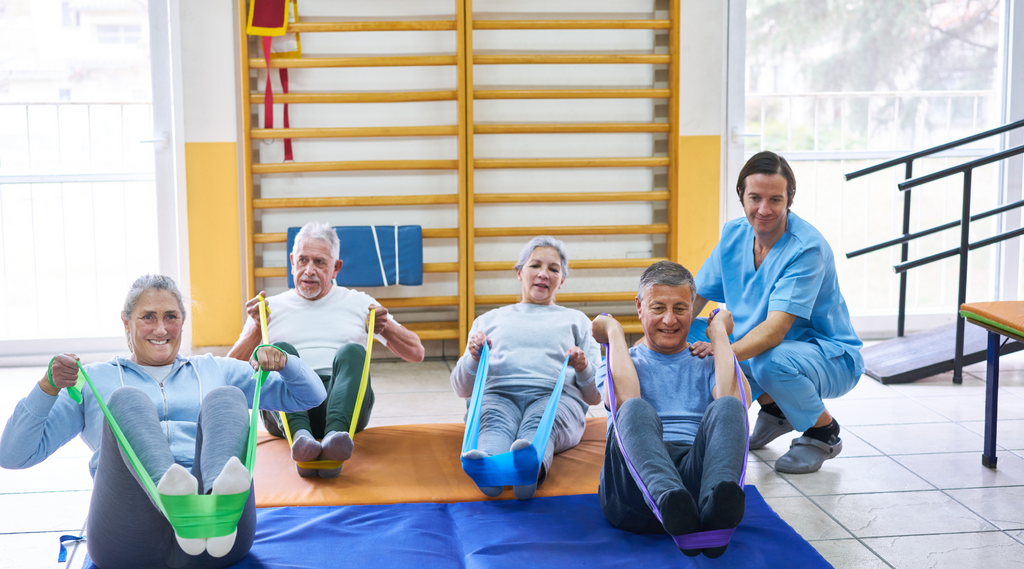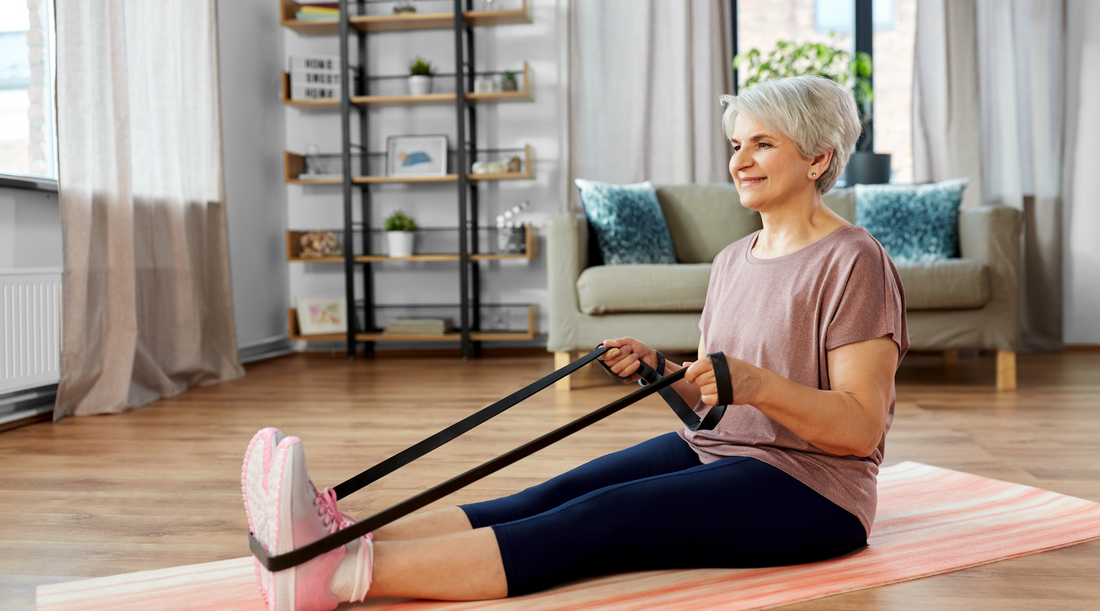As we grow older, our bodies naturally undergo a deterioration process, with functions gradually declining and a sense of youthful vigor waning. Many individuals, from their late twenties through retirement, often prioritize their careers over physical health, leaving them susceptible to age-related declines in performance.
As we age, the importance of maintaining physical fitness becomes increasingly evident, regardless of our stage in life. Regular physical activities, even in later years, can significantly benefit mental and physical well-being, thereby preserving our independence as we grow older. Senior fitness with resistance bands is highly recommended, as it can effectively counteract the loss of muscle mass and strength associated with aging.
As muscles lose flexibility and strength, traditional workouts may pose greater risks for seniors. Therefore, tailored guidelines for senior fitness, such as those emphasizing resistance band exercises, are essential for promoting optimal health and well-being among older individuals.
Benefits of Senior Exercises Using Resistance Bands

Improved Strength and Muscle Tone
Participating in exercises with resistance bands for seniors can boost muscle strength and tone. As people age, muscle mass naturally diminishes, resulting in weakness and decreased mobility. Resistance band workouts are gentle on the joints, making them appropriate for seniors, especially those with discomfort or limited mobility. Moreover, these workouts encourage seniors to activate their core muscles for stability and replicate everyday motions, aiding in the enhancement of functional strength without imposing strain on already delicate muscles.
Enhanced Flexibility and Range of Motion
Seniors need to uphold flexibility to carry out everyday tasks and avoid injuries. Resistance band exercises for seniors can be used to perform dynamic stretching exercises, which involve moving through a range of motion while gradually increasing muscle strength. This helps improve flexibility by elongating the muscles and increasing their elasticity.
Further, resistance band exercises concentrate on particular muscle groups and joints, fostering improved joint mobility. As seniors engage in exercises that stretch and reinforce the muscles surrounding their joints, they can enhance flexibility and range of motion in those specific areas.
Joint Health and Functionality
Senior fitness using resistance bands supports joint health and functionality. Resistance bands provide a gentle yet effective form of strength training that doesn’t strain the joints while still offering resistance to the muscles. This aids seniors in building strength without overburdening their joints, thereby promoting joint health.
Further, resistance bands strengthen the muscles surrounding the joints, enhancing support and stability. Stronger muscles alleviate pressure and reduce the load on the joints during movement, helping to alleviate joint pain and discomfort.
Enhanced Balance and Coordination
Preserving balance and coordination is vital for averting falls and upholding independence. When using resistance bands, seniors must activate their stabilizing muscles to uphold proper form throughout the exercises. This continual activation aids in enhancing proprioception, which is the body’s capacity to perceive its position in space, thus refining muscles, including the abdominals, obliques, and lower back. A robust core is pivotal for sustaining balance and stability, as it provides support to the spines and pelvis during movement. By fortifying core muscles, seniors can enhance their balance and coordination.
Getting Started with Senior Fitness

Consultation with a Healthcare Professional
Before beginning any exercise program, seniors should consult a healthcare professional to evaluate their current fitness level and address any potential concerns or limitations. Seniors may possess underlying medical conditions like arthritis, osteoporosis, cardiovascular issues, or joint problems that could be influenced by exercise. With the assistance of a healthcare professional, these conditions can be evaluated, and guidelines on suitable exercises and modifications can be provided to ensure safety and efficiency.
Some medications seniors may be taking could also affect their ability to exercise safely. Seeking guidelines from a healthcare professional facilitates the review of medications and potential interactions or side effects that might affect exercise performance or safety.
Choosing the Right Resistance Bands
Selecting resistance bands with the right level of resistance ensures that seniors can perform exercises at an intensity that matches their current strength and fitness level. Bands that are too easy may not provide enough challenges while bands that are too difficult can increase the risk of injury. The right resistance bands can also help seniors perform exercises safely and effectively. Bands that are too stiff or rigid can strain muscles and joints, while bands that are too loose may not provide enough resistance to stimulate muscle growth. Choosing the band with the appropriate elasticity and resistance allows seniors to engage in workouts that are both safe and beneficial.
Incorporating Variety into Workouts
Exercise bands provide seniors with a flexible array of exercises that can be customized to their unique needs and fitness levels, thus introducing diversity into their exercise routine. These bands target various muscle groups, enabling seniors to concentrate on specific body areas during workouts, and ensuring a comprehensive exercise plan. Additionally, resistance bands are available in a range of resistance levels, from light to heavy, empowering seniors to select bands that match their current strength and fitness capacities. They can effortlessly modify workout intensity by using bands with different resistance levels. Frequently, resistance band color coding denotes the band’s strength.
Practicing Proper Form and Technique
Proper form and technique are critical for maximizing the benefits of resistance band exercises while minimizing the risk of injury. Proper form and technique help seniors avoid injuries during resistance band exercises. Performing exercises with incorrect form can strain muscles, ligaments, and joints, leading to discomfort or injury. By using proper techniques, seniors can minimize the risk of strains, sprains, and other workout-related injuries.
Focusing on proper form and techniques also encourages seniors to develop a great awareness of their bodies and how they move during exercise. This mind-body connection can lead to improved coordination, concentration, and mindfulness during workouts.
Consistency and Progression
Consistency plays a crucial role in reaching long-term fitness objectives. Senior individuals benefit from regular workouts using stretchy exercise bands to sustain and develop strength over time. Participating consistently in resistance exercises allows seniors to experience a gradual enhancement in muscle mass and overall muscular strength, essential for upholding independence and completing daily tasks.
By adhering to regular workouts and progressively advancing the intensity and complexity of exercises, seniors can witness notable improvements in strength, balance, and overall well-being, ultimately leading to a healthier and more active lifestyle.
Resistance Band Exercises for Seniors

Before starting, it's crucial to proceed with caution. Begin by incorporating light warm-up exercises like brisk walking. Additionally, start your workout gradually and avoid overexertion. Always commence with light resistance bands, such as yellow bands in the exercise band color code. Ensure to consult a healthcare professional before engaging in any of these exercises.
Leg Press
- Sit on a sturdy chair or bench, maintain proper posture with your back upright, and secure the resistance band around your feet.
- Grasp the handles with each hand, extend your legs in front of you, and gradually push against the resistance provided by the band.
- Hold the position for a moment, then bend your knees to return to the starting position.
- Ensure that your back is always against the chair to retain control throughout the movement.
■ Perform 10-12 repetitions.
Calf Press
- Take a seat in a chair or on a bench with your back upright, and hold both ends of the resistance band.
- Wrap the center of the band around your left foot and extend the foot outward.
- After fully extending, direct your toes upward, maintaining a straight foot position.
- Slowly lower your toes toward the floor as if pressing against a paddle.
- Repeat the movement 10-15 times before switching feet.
■ Perform 10-12 repetitions.
Bent over Row (Seated)
- Sit on the chair with both your feet positioned on the band, spaced hip-width apart.
- Hold the handles in both hands, extending your arm fully in front of you.
- Lean forward at the hips while maintaining a straight back and keeping your chest facing forward.
- Slowly, draw the handles towards your hips, while building strength by squeezing your shoulder blades together.
- Gradually relax the tension to return to the initial position.
■ Repeat the exercise for 10-12 times.
Glute Bridges
- Sit on the floor with your feet spaced hip-width apart.
- Wrap the resistance band around your thighs, positioning it just above your knees.
- Lie flat on the mat with your arms resting at your sides.
- Lift your hips, press through your heels, and use your arms to elevate your back. Continue pushing until your body forms a straight line from your shoulders to knees.
- Extend the resistance band by moving your knees apart.
- Gradually return to the initial position.
■ Strive to complete 10 repetitions.
Reverse Fly
- Anchor the resistance band under your feet while gripping each end with your hands.
- Gently bend your elbows and raise your arms outward, lifting them to shoulder height.
- Pause at the peak for a second, then gradually relax the tension to lower your arms.
■ Perform 10-12 repetitions.
Discover the Power of Resistance Bands for Every Age

Taking control of our physical fitness should begin right away. While maintaining fitness as a senior holds significance, it's essential to recognize that your present efforts will benefit you as you age. With numerous options available to stay in shape, without requiring a gym membership or dedicating extensive hours, taking care of your physical well-being shouldn't be challenging.
According to the National Library of Medicine, exercise enhances mental health by reducing anxiety, depression, and negative mood, while also improving self-esteem and cognitive function. Exercise has also been shown to alleviate symptoms such as low self-esteem and social withdrawal. Consequently, fitness enthusiasts and experts have devised various ways for individuals to engage in workouts, even if it's just for 10 or 15 minutes a day, which is less than the time needed for a typical work break. One of these methods involves integrating resistance band exercises.
Embark on your fitness journey by acquiring a bulk resistance band or a starter kit from Super Exercise Band, offering heavy-duty bands suitable for every age and fitness level. You also have the option to select non-latex resistance bands, as well as mini loop bands, and super size bands, which are our best-selling 7-inch TPE bands designed for beginners, fitness enthusiasts, and everyone in between. Begin your resistance band workout at any time.
Invest in your health through resistance band workouts.
The content provided on this blog is for informational purposes only and is not intended as professional medical advice. The information shared here should not be used to diagnose or treat any health problems or illnesses without consulting a qualified healthcare
professional. Always seek the advice of your physician or other qualified healthcare provider with any questions you may have regarding a medical condition. Never disregard professional medical advice or delay in seeking it because of something you have read on this blog. Reliance on any information provided by this blog is solely at your own risk.

